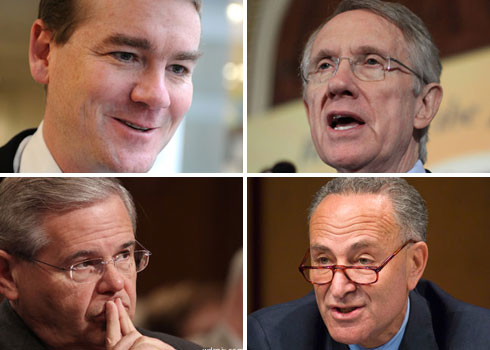The public option has been alive, then dead, then alive, then dead so many times now it’s enough to make your head spin. Right now it’s somewhere in between–an undead public option, still beloved by a large majority of Democrats, but, for now, lacking the political leadership needed to usher it through the legislative process. Nevertheless, the fact that it has a pulse is remarkable in and of itself…so how did we get here all over again? Though the latest action is all in the Senate, the momentum re-emerged in the House.
“We had heard on the House side that [Colorado Rep. Jared] Polis was talking behind the scenes with folks about why a public option wasn’t being pushed,” says Adam Green, co-founder of the Progressive Change Campaign Committee–one of several progressive pressure groups (including Democracy for America, and Credo) pushing the public option.
That touched off a symbiotic relationship. If Polis, and fellow public option supporter Rep. Chellie Pingree (D-ME) would work the inside game in the House, the groups would build pressure from the outside, and together they could build a formidable list of signatories to a letter.
“In about a week we got 118 people on the letter in the House,” Green says.
To build on that success, the groups and members needed a parallel effort in the Senate. For that, Polis turned to his Colorado co-delegate, Sen. Michael Bennet.
“We were looking for a similar effort on the Senate side, and thinking of who would be a credible,” Green says. “[Polis] apparently called Bennet personally.”
The fruits of joining the push were undeniable: favorable press coverage, and a groundswell of support from the grassroots. Bennet’s team bit.
“They decided they wanted to do it, and they brought in [Sherrod] Brown and [Jeff] Merkley and we reached out to Gillibrand’s folks and brought them in,” Green says.
Bennet’s staff says that they’re not treating the public option as a make or break issue, but that they’re extremely pleased that the conversation has grown as quickly as it has. All parties–the outside groups, the public option backers in the Senate, Democratic leadership–have been surprised by the momentum. Many of them pleasantly. Days after the push began in earnest, the Senate letter has already been signed by 23 members.
“I would credit a lot the Netroots and then working with members who had already been previously supportive, and members who have been in tough positions for re-election,” says a top Democratic Senate aide.
“We progressed faster than we expected on the Senate side,” Green says.
“Bennet coming out first really helped with credibility, same with Gillibrand,” Green says. (Both Bennet and Gillibrand are up for re-election.) “On the way picking up Tom Udall, picking up Jeanne Shaheen–who are not voices you usually hear on the public option–really helped.”
The support from leadership put the effort into overdrive.
“With Schumer and Menendez it’s a poitcal validator, because you know they won’t back something that’s a political loser,” Green says. “Harry Reid is like a leadership validator. People who sign the letter aren’t at odds with leadership anymore. They’re saying they have Reid’s back.”
The result has been a cascade of support from across the Democratic party–including, yesterday, the addition of Sen. Tim Johnson of conservative South Dakota to the list of signatories. And that could lead to more.
“Ultimately we want to get to 50. Our short term goal is to get to 40 which would build an air of inevitability around this. At this rate, we’re picking up one or two a day, a week from now we should be approaching 40,” Green says.
Of course, there have been some setbacks. Sen. Jay Rockefeller (D-WV)–a die-hard public option supporter–came out against the strategy yesterday. And procedural questions remain unanswered. The groups want the public option to be built in to the reconciliation bill from the get go. That would lock it in, forcing leadership to find 50 votes for it. Leadership, though, may be more inclined to allow an up or down vote on a public option amendment, so that the hunt for 50 votes doesn’t imperil the entire health care reform effort.
“We’re not willing to go down the same path I think that we went down in December where we see things fall apart over one specific provision,” says a Dem leadership aide.
A few things are perfectly clear: The White House isn’t helping in this effort at all. And some Democrats, both among the rank and file, and in leadership, are nervous about the push. But the popularity of the provision, both among Democratic members and the voting public have thusfar provided enough of a counterweight to keep the public option an open question.










